Quantitative Assessment and Regulation of Passage and Entrance Attraction Efficiency of Vertical-Slot Fishway on Heishuihe River in Southwest China
Abstract
:Simple Summary
Abstract
1. Introduction
2. Materials and Methods
2.1. Study Area
2.2. Experimental Methods
2.2.1. Fish Resource Survey
2.2.2. Net Collection Experiment
2.2.3. Fish Passage Efficiency Experiment
2.3. Data Analysis
3. Results
3.1. Fish Resources in the Downstream River
3.2. Spatial and Temporal Patterns of Fish Passage over the Dam
3.3. Assessment of Fishway Entrance Attraction Efficiency
3.4. Assessment of Fishway Passage Efficiency
3.5. Diurnal and Nocturnal Rhythms in Fish Passage over the Weir
3.6. Fish Upstream Behavior at Different Flow Rates and Water Temperatures
4. Discussion
4.1. Spatial and Temporal Patterns of Fish Migration
4.2. Fishway Efficiency Assessment and Diagnosis
4.3. Identification of Key Factors Affecting Fish Upstream Migration
5. Conclusions
Author Contributions
Funding
Institutional Review Board Statement
Informed Consent Statement
Data Availability Statement
Conflicts of Interest
References
- Doehring, K.; Young, R.G.; McIntosh, A.R. Factors affecting juvenile galaxiid fish passage at culverts. Mar. Freshw. Res. 2011, 62, 38–45. [Google Scholar] [CrossRef]
- Hall, C.J.; Jordaan, A.; Frisk, M.G. The historic influence of dams on diadromous fish habitat with a focus on river herring and hydrologic longitudinal connectivity. Landsc. Ecol. 2011, 26, 95–107. [Google Scholar] [CrossRef]
- García, A.; Jorde, K.; Habit, E.; Caamaño, D.; Parra, O. Downstream environmental effects of dam operations: Changes in habitat quality for native fish species. River Res. Appl. 2011, 27, 312–327. [Google Scholar] [CrossRef]
- Newbold, L.R.; Shi, X.; Hou, Y.; Han, D.; Kemp, P.S. Swimming performance and behaviour of bighead carp (Hypophthalmichthys nobilis): Application to fish passage and exclusion criteria. Ecol. Eng. 2016, 95, 690–698. [Google Scholar] [CrossRef]
- Santos, J.M.; Ferreira, M.T.; Pinheiro, A.N.; Bochechas, J.H. Effects of small hydropower plants on fish assemblages in medium-sized streams in central and northern Portugal. Aquat. Conserv. Mar. Freshw. Ecosyst. 2006, 16, 373–388. [Google Scholar] [CrossRef]
- Dodd, J.R.; Cowx, I.G.; Bolland, J.D. Efficiency of a nature-like bypass channel for restoring longitudinal connectivity for a river-resident population of brown trout. J. Environ. Manag. 2017, 204, 318–326. [Google Scholar] [CrossRef]
- Pennock, C.A.; Bender, D.; Hofmeier, J.; Mounts, J.A.; Waters, R.; Weaver, V.D.; Gido, K.B. Can fishways mitigate fragmentation effects on Great Plains fish communities? Can. J. Fish. Aquat. Sci. 2018, 75, 121–130. [Google Scholar] [CrossRef]
- Tummers, J.S.; Hudson, S.; Lucas, M.C. Evaluating the effectiveness of restoring longitudinal connectivity for stream fish communities: Towards a more holistic approach. Sci. Total Environ. 2016, 569, 850–860. [Google Scholar] [CrossRef] [PubMed]
- Qin, Y.; Wei, Q.; Ji, Q.; Li, K.; Liang, R.; Wang, Y. Determining the position of a fish passage facility entrance based on endemic fish swimming abilities and flow field. Environ. Sci. Pollut. Res. 2023, 30, 6104–6116. [Google Scholar] [CrossRef] [PubMed]
- Hershey, H. Updating the consensus on fishway efficiency: A meta-analysis. Fish Fish. 2021, 22, 735–748. [Google Scholar] [CrossRef]
- Noonan, M.J.; Grant, J.W.A.; Jackson, C.D. A quantitative assessment of fish passage efficiency. Fish Fish. 2012, 13, 450–464. [Google Scholar] [CrossRef]
- Quaranta, E.; Katopodis, C.; Comoglio, C. Effects of bed slope on the flow field of vertical slot fishways. River Res. Appl. 2019, 35, 656–668. [Google Scholar] [CrossRef]
- Chen, A.; Wu, M.; Chen, K.-q.; Sun, Z.-y.; Shen, C.; Wang, P.-y. Main issues in research and practice of environmental protection for water conservancy and hydropower projects in China. Water Sci. Eng. 2016, 9, 312–323. [Google Scholar] [CrossRef]
- Cooke, S.J.; Hinch, S.G. Improving the reliability of fishway attraction and passage efficiency estimates to inform fishway engineering, science, and practice. Ecol. Eng. 2013, 58, 123–132. [Google Scholar] [CrossRef]
- Quintella, B.; Mateus, C.S.; Alexandre, C.M.; Cardoso, G.R.; Belo, A.F.; Pereira, E.D.; Almeida, P.R. Session c7: Passage efficiency and behavior of adult sea lamprey in a vertical-slot fishway. In Proceedings of the International Conference on Engineering and Ecohydrology for Fish Passage 2015, Groningen, The Netherland, 22–24 June 2015. [Google Scholar]
- Garavelli, L.; Linley, T.J.; Bellgraph, B.J.; Rhode, B.M.; Janak, J.M.; Colotelo, A.H. Evaluation of passage and sorting of adult Pacific salmonids through a novel fish passage technology. Fish. Res. 2019, 212, 40–47. [Google Scholar] [CrossRef]
- LeRoy, J.Z.; Davis, J.J.; Shanks, M.R.; Jackson, P.R.; Murphy, E.A.; Baxter, C.L.; McInerney, M.K. Efficacy of increasing discharge to reduce tow-mediated fish passage across an electric dispersal barrier system in a confined channel. J. Great Lakes Res. 2019, 45, 1320–1331. [Google Scholar] [CrossRef]
- Baumgartner, L.J.; Barlow, C.; Mallen-Cooper, M.; Boys, C.; Marsden, T.; Thorncraft, G.; Roy, M. Achieving fish passage outcomes at irrigation infrastructure; a case study from the Lower Mekong Basin. Aquac. Fish. 2021, 6, 113–124. [Google Scholar] [CrossRef]
- Tan, J.; Tan, H.; Goerig, E.; Ke, S.; Huang, H.; Liu, Z.; Shi, X. Optimization of fishway attraction flow based on endemic fish swimming performance and hydraulics. Ecol. Eng. 2021, 170, 106332. [Google Scholar] [CrossRef]
- Chen, M.; An, R.; Li, J.; Li, K.; Li, F. Identifying operation scenarios to optimize attraction flow near fishway entrances for endemic fishes on the Tibetan Plateau of China to match their swimming characteristics: A case study. Sci. Total Environ. 2019, 693, 133615. [Google Scholar] [CrossRef]
- Fritts, A.K.; Knights, B.C.; Stanton, J.C.; Milde, A.S.; Vallazza, J.M.; Brey, M.K.; Lamer, J.T. Lock operations influence upstream passages of invasive and native fishes at a Mississippi River high-head dam. Biol. Invas. 2021, 23, 771–794. [Google Scholar] [CrossRef]
- Benitez, J.P.; Ovidio, M. The influence of environmental factors on the upstream movements of rheophilic cyprinids according to their position in a river basin. Ecol. Freshw. Fish. 2018, 27, 660–671. [Google Scholar] [CrossRef]
- Goerig, E.; Wasserman, B.A.; Castro-Santos, T.; Palkovacs, E.P. Body shape is related to the attempt rate and passage success of brook trout at in-stream barriers. J. Appl. Ecol. 2020, 57, 91–100. [Google Scholar] [CrossRef]
- Harbicht, A.B.; Castro-Santos, T.; Gorsky, D.; Hand, D.M.; Fraser, D.J.; Ardren, W.R. Environmental, anthropogenic, and dietary influences on fine-scale movement patterns of Atlantic salmon through challenging waters. Can. J. Fish. Aquat. Sci. 2018, 75, 2198–2210. [Google Scholar] [CrossRef]
- Goerig, E.; Castro-Santos, T. Is motivation important to brook trout passage through culverts? Can. J. Fish. Aquat. Sci. 2017, 74, 885–893. [Google Scholar] [CrossRef]
- Wang, Y.; Wai, O.W.H.; Chen, Q. Laboratory study on fish behavioral response to meandering flow and riffle-pool sequence driven by deflectors in straight concrete flood channels. J. Hydrol. 2021, 598, 125736. [Google Scholar] [CrossRef]
- Bayse, S.M.; McCormick, S.D.; Castro-Santos, T. How lipid content and temperature affect American shad (Alosa sapidissima) attempt rate and sprint swimming: Implications for overcoming migration barriers. Can. J. Fish. Aquat. Sci. 2019, 76, 2235–2244. [Google Scholar] [CrossRef]
- Ding, R.H. The Fishes of Sichuan; Sichuan Science and Technology Publishing House: Chengdu, China, 1994. [Google Scholar]
- McCain, J.S.P.; Rangeley, R.W.; Schneider, D.C.; Lotze, H.K. Historical abundance of juvenile commercial fish in coastal habitats: Implications for fish habitat management in Canada. Mar. Policy 2016, 73, 235–243. [Google Scholar] [CrossRef]
- Aparicio, E.; Pintor, C.; Duran, M.C.; Carmona Catot, G. Fish passage assessment at the most downstream barrier of the Ebro River (NE Iberian Peninsula). Limnetica 2012, 31, 37–46. [Google Scholar] [CrossRef]
- Smith, S.C.F.; Meiners, S.J.; Hastings, R.P.; Thomas, T.; Colombo, R.E. Low-head dam impacts on habitat and the functional composition of fish communities. River Res. Appl. 2017, 33, 680–689. [Google Scholar] [CrossRef]
- Keefer, M.L.; Peery, C.A.; Bjornn, T.C.; Jepson, M.A.; Stuehrenberg, L.C. Hydrosystem, dam, and reservoir passage rates of adult Chinook salmon and steelhead in the Columbia and Snake rivers. Trans. Am. Fish. Soc. 2004, 133, 1413–1439. [Google Scholar] [CrossRef]
- Yoon, J.D.; Kim, J.H.; Yoon, J.; Baek, S.H.; Jang, M.H. Efficiency of a modified Ice Harbor-type fishway for Korean freshwater fishes passing a weir in South Korea. Aquat. Ecol. 2015, 49, 417–429. [Google Scholar] [CrossRef]
- Epple, T.; Friedmann, A.; Wetzel, K.-F.; Born, O.; Müller, G. The migration of four salmonid species through fish bypass channels depending on environmental factors. Environ. Biol. Fish. 2022, 105, 2099–2117. [Google Scholar] [CrossRef]
- Tamario, C.; Sunde, J.; Petersson, E.; Tibblin, P.; Forsman, A. Ecological and evolutionary consequences of environmental change and management actions for migrating fish. Front. Ecol. Evol. 2019, 7, 271. [Google Scholar] [CrossRef]
- Katopodis, C.; Williams, J.G. The development of fish passage research in a historical context. Ecol. Eng. 2012, 48, 8–18. [Google Scholar] [CrossRef]
- Sanz-Ronda, F.J.; Bravo-Córdoba, F.J.; Fuentes-Pérez, J.F.; Castro-Santos, T. Ascent ability of brown trout, Salmo trutta, and two Iberian cyprinids− Iberian barbel, Luciobarbus bocagei, and northern straight-mouth nase, Pseudochondrostoma duriense− in a vertical slot fishway. Knowl. Manag. Aquat. Ecosyst. 2016, 417, 10. [Google Scholar] [CrossRef]
- Lopes, J.d.M.; Alves, C.B.M.; Peressin, A.; Pompeu, P.S. Dazed and confused: Behavioural constraints impose major challenges to fish passage in the neotropics. Aquat. Conserv. Mar. Freshwater Ecosyst. 2021, 31, 3403–3415. [Google Scholar] [CrossRef]
- Xie, O.; Sun, Z.; Shen, C. A study on flow field characteristics of a self-propelled robot fish approaching static obstacles based on artificial lateral line. Bioinspirat. Biomimet. 2023, 18, 036008. [Google Scholar] [CrossRef] [PubMed]
- Burnett, N.J.; Hinch, S.G.; Bett, N.N.; Braun, D.C.; Casselman, M.T.; Cooke, S.J.; Minke-Martin, V. Reducing carryover effects on the migration and spawning success of sockeye salmon through a management experiment of dam flows. River Res. Appl. 2017, 33, 3–15. [Google Scholar] [CrossRef]
- Green, T.M.; Lindmark, E.M.; Lundström, T.S.; Gustavsson, L.H. Flow characterization of an attraction channel as entrance to fishways. River Res. Appl. 2011, 27, 1290–1297. [Google Scholar] [CrossRef]
- Vowles, A.S.; Kemp, P.S. Effects of light on the behaviour of brown trout (Salmo trutta) encountering accelerating flow: Application to downstream fish passage. Ecol. Eng. 2012, 47, 247–253. [Google Scholar] [CrossRef]
- Bao, J.; Li, W.; Zhang, C.; Mi, X.; Li, H.; Zhao, X.; Duan, M. Quantitative assessment of fish passage efficiency at a vertical-slot fishway on the Daduhe River in Southwest China. Ecol. Eng. 2019, 141, 105597. [Google Scholar] [CrossRef]
- Golpira, A.; Baki, A.B.M.; Zhu, D.Z. Higher-order velocity moments, turbulence scales and energy dissipation rate around a boulder in a rock-ramp fish passage. Sustainability 2020, 12, 5385. [Google Scholar] [CrossRef]
- Quaranta, E.; Katopodis, C.; Revelli, R.; Comoglio, C. Turbulent flow field comparison and related suitability for fish passage of a standard and a simplified low-gradient vertical slot fishway. River Res. Appl. 2017, 33, 1295–1305. [Google Scholar] [CrossRef]
- Schuetz, C.; Henning, M.; Czerny, R.; Herbst, M.; Pitsch, M. Addition of auxiliary discharge into a fishway–a contribution to fishway design at barrages of large rivers. Ecol. Eng. 2021, 167, 106257. [Google Scholar] [CrossRef]
- de Oliveira Mesquita, F.; Godinho, H.P.; de Azevedo, P.G.; Young, R.J. A preliminary study into the effectiveness of stroboscopic light as an aversive stimulus for fish. Appl. Anim. Behav. Sci. 2008, 111, 402–407. [Google Scholar] [CrossRef]
- Vetter, B.J.; Murchy, K.A.; Cupp, A.R.; Amberg, J.J.; Gaikowski, M.P.; Mensinger, A.F. Acoustic deterrence of bighead carp (Hypophthalmichthys nobilis) to a broadband sound stimulus. J. Great Lakes Res. 2017, 43, 163–171. [Google Scholar] [CrossRef]
- Castro-Santos, T. Optimal swim speeds for traversing velocity barriers: An analysis of volitional high-speed swimming behavior of migratory fishes. J. Exp. Biol. 2005, 208, 421–432. [Google Scholar] [CrossRef]
- Ovidio, M.; Sonny, D.; Dierckx, A.; Watthez, Q.; Bourguignon, S.; de Le Court, B.; Benitez, J.P. The use of behavioural metrics to evaluate fishway efficiency. River Res. Appl. 2017, 33, 1484–1493. [Google Scholar] [CrossRef]
- Aarestrup, K.; Baktoft, H.; Thorstad, E.B.; Svendsen, J.C.; Höjesjö, J.; Koed, A. Survival and progression rates of anadromous brown trout kelts Salmo trutta during downstream migration in freshwater and at sea. Mar. Ecol. Progr. Ser. 2015, 535, 185–195. [Google Scholar] [CrossRef]
- Benitez, J.-P.; Dierckx, A.; Matondo, B.N.; Rollin, X.; Ovidio, M. Movement behaviours of potamodromous fish within a large anthropised river after the reestablishment of the longitudinal connectivity. Fish. Res. 2018, 207, 140–149. [Google Scholar] [CrossRef]
- Bunt, C.M.; Castro-Santos, T.; Haro, A. Performance of fish passage structures at upstream barriers to migration. River Res. Appl. 2012, 28, 457–478. [Google Scholar] [CrossRef]
- Silva, A.T.; Santos, J.M.; Ferreira, M.T.; Pinheiro, A.N.; Katopodis, C. Effects of water velocity and turbulence on the behaviour of Iberian barbel (Luciobarbus bocagei, Steindachner 1864) in an experimental pool-type fishway. River Res. Appl. 2011, 27, 360–373. [Google Scholar] [CrossRef]
- White, L.J.; Harris, J.H.; Keller, R.J. Movement of three non-salmonid fish species through a low-gradient vertical-slot fishway. River Res. Appl. 2011, 27, 499–510. [Google Scholar] [CrossRef]
- Liu, Q.; Zhang, P.; Cheng, B.; Li, Y.; Li, J.; Zhou, H.; Lu, Y. Incorporating the life stages of fish into habitat assessment frameworks: A case study in the Baihetan Reservoir. J. Environ. Manag. 2021, 299, 113663. [Google Scholar] [CrossRef]
- Lehman, B.; Huff, D.D.; Hayes, S.A.; Lindley, S.T. Relationships between Chinook salmon swimming performance and water quality in the San Joaquin River, California. Trans. Am. Fish. Soc. 2017, 146, 349–358. [Google Scholar] [CrossRef]
- Samaras, A.; Papandroulakis, N.; Lika, K.; Pavlidis, M. Water temperature modifies the acute stress response of European sea bass, Dicentrarchus labrax L. (1758). J. Therm. Biol. 2018, 78, 84–91. [Google Scholar] [CrossRef]
- Cai, L.; Liu, G.; Taupier, R.; Fang, M.; Johnson, D.; Tu, Z.; Huang, Y. Effect of temperature on swimming performance of juvenile Schizothorax prenanti. Fish Physiol. Biochem. 2014, 40, 491–498. [Google Scholar] [CrossRef] [PubMed]
- Salinger, D.H.; Anderson, J.J. Effects of water temperature and flow on adult salmon migration swim speed and delay. Trans. Am. Fish. Soc. 2006, 135, 188–199. [Google Scholar] [CrossRef]
- Pereira, E.; Cardoso, G.R.; Quintella, B.R.; Mateus, C.S.; Alexandre, C.M.; Oliveira, R.L.; Batista, C.M. Proposals for optimizing sea lamprey passage through a vertical-slot fishway. Ecohydrology 2019, 12, e2087. [Google Scholar] [CrossRef]
- Baker, N.J.; Boubée, J.; Lokman, P.M.; Bolland, J.D. Evaluating the impact of hydropower on downstream migrating anguillid eels: Catchment-wide and fine-scale approaches to identify cost-effective solutions. Sci. Total Environ. 2020, 748, 141111. [Google Scholar] [CrossRef]
- Hou, Y.; Yang, Z.; An, R.; Cai, L.; Chen, X.; Zhao, X.; Zou, X. Water flow and substrate preferences of Schizothorax wangchiachii (Fang, 1936). Ecol. Eng. 2019, 138, 1–7. [Google Scholar] [CrossRef]
- López-Olmeda, J.F.; López-García, I.; Sánchez-Muros, M.J.; Blanco-Vives, B.; Aparicio, R.; Sánchez-Vázquez, F.J. Daily rhythms of digestive physiology, metabolism and behaviour in the European eel (Anguilla anguilla). Aquac. Int. 2012, 20, 1085–1096. [Google Scholar] [CrossRef]
- Lagarde, R.; Teichert, N.; Boussarie, G.; Grondin, H.; Valade, P. Upstream migration of amphidromous gobies of La Réunion Island: Implication for management. Fish. Manag. Ecol. 2015, 22, 437–449. [Google Scholar] [CrossRef]



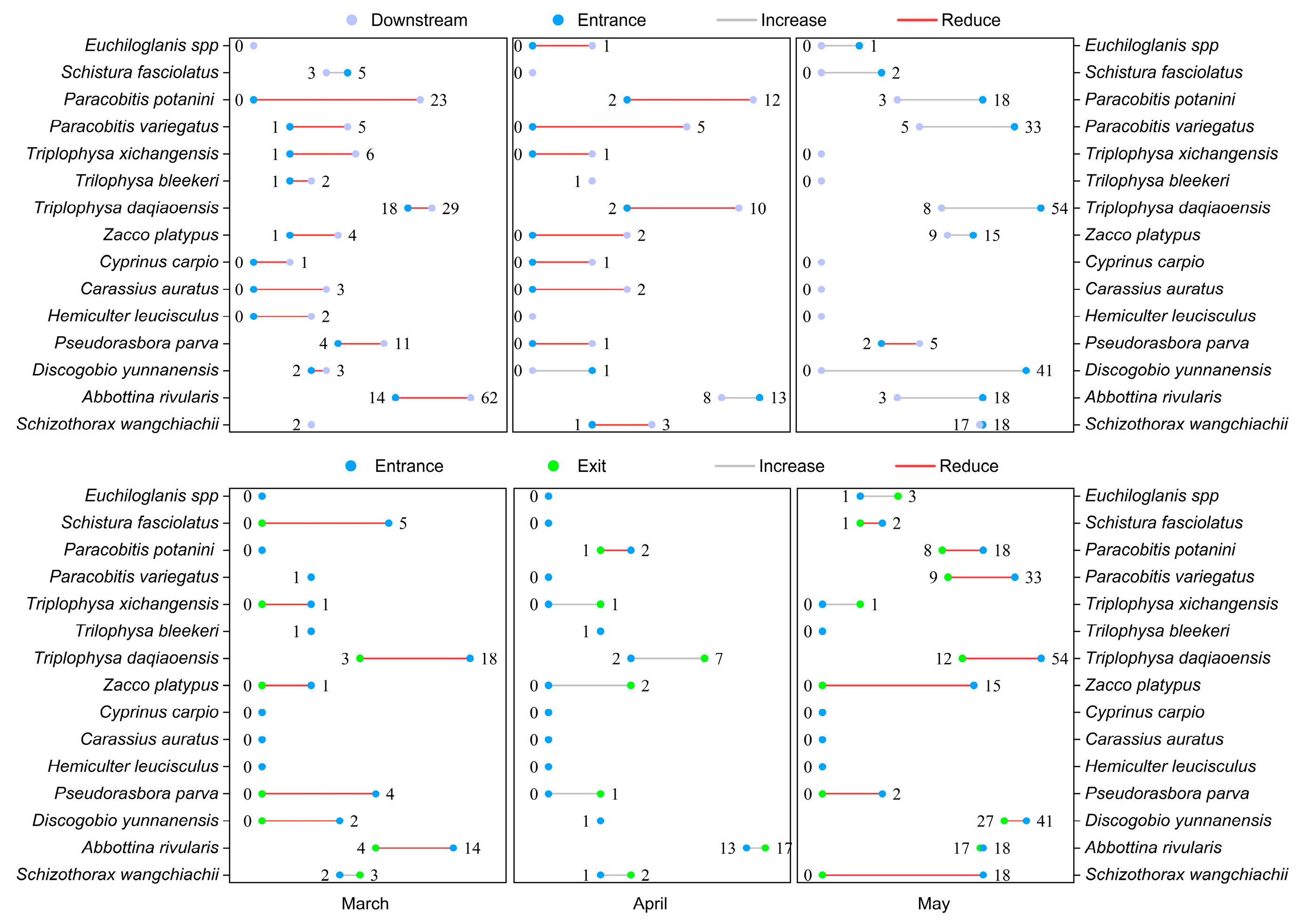
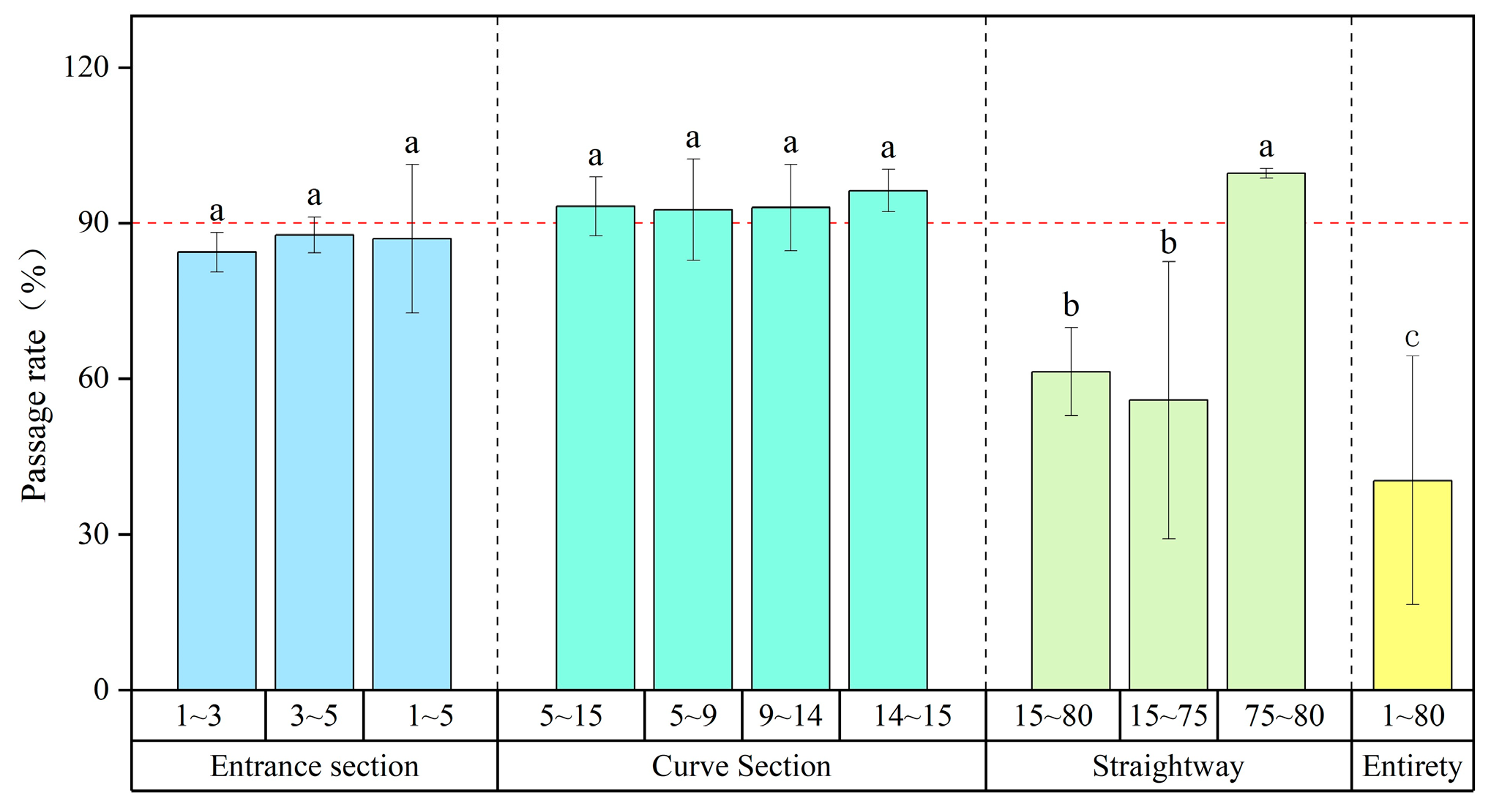
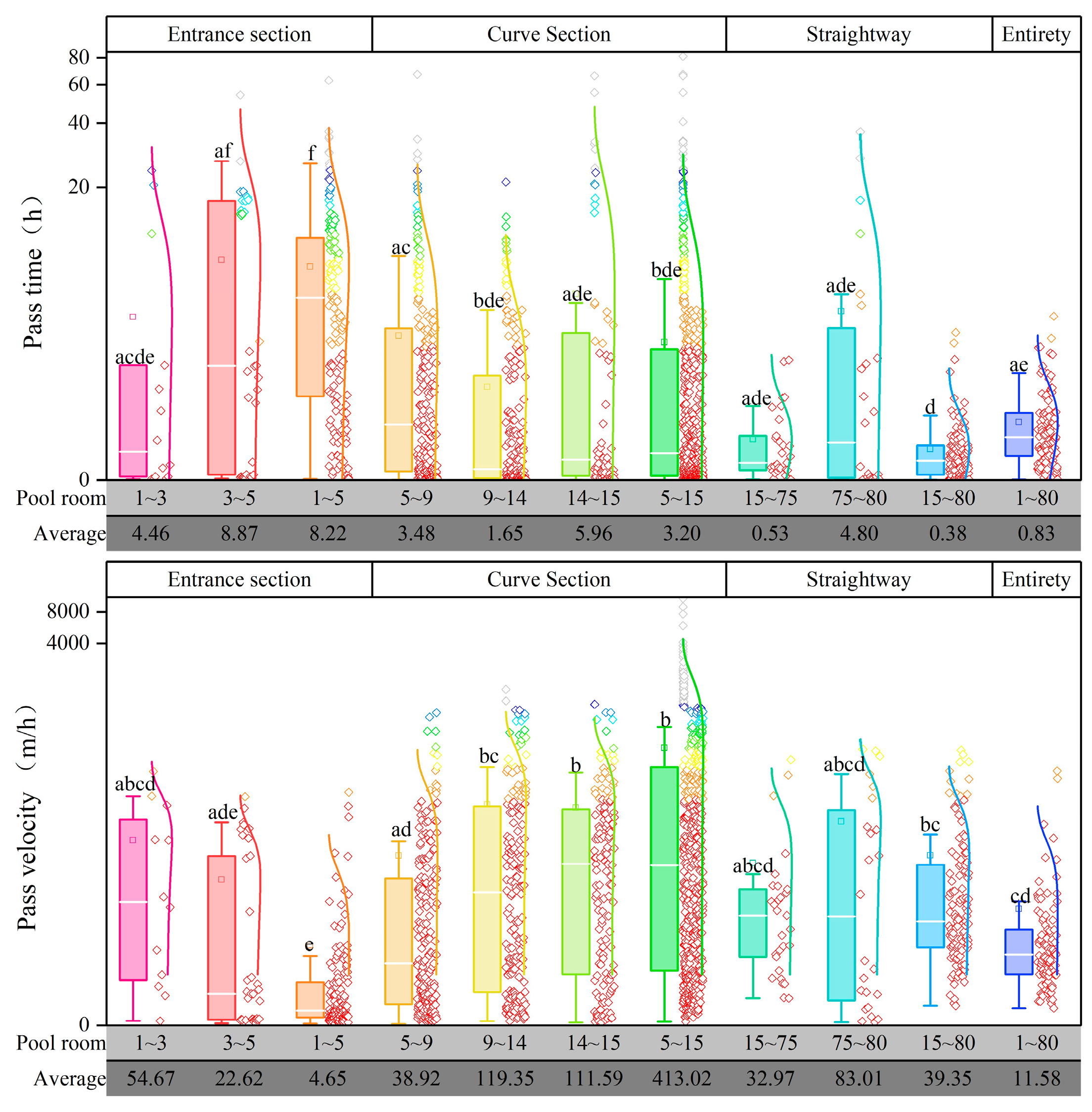
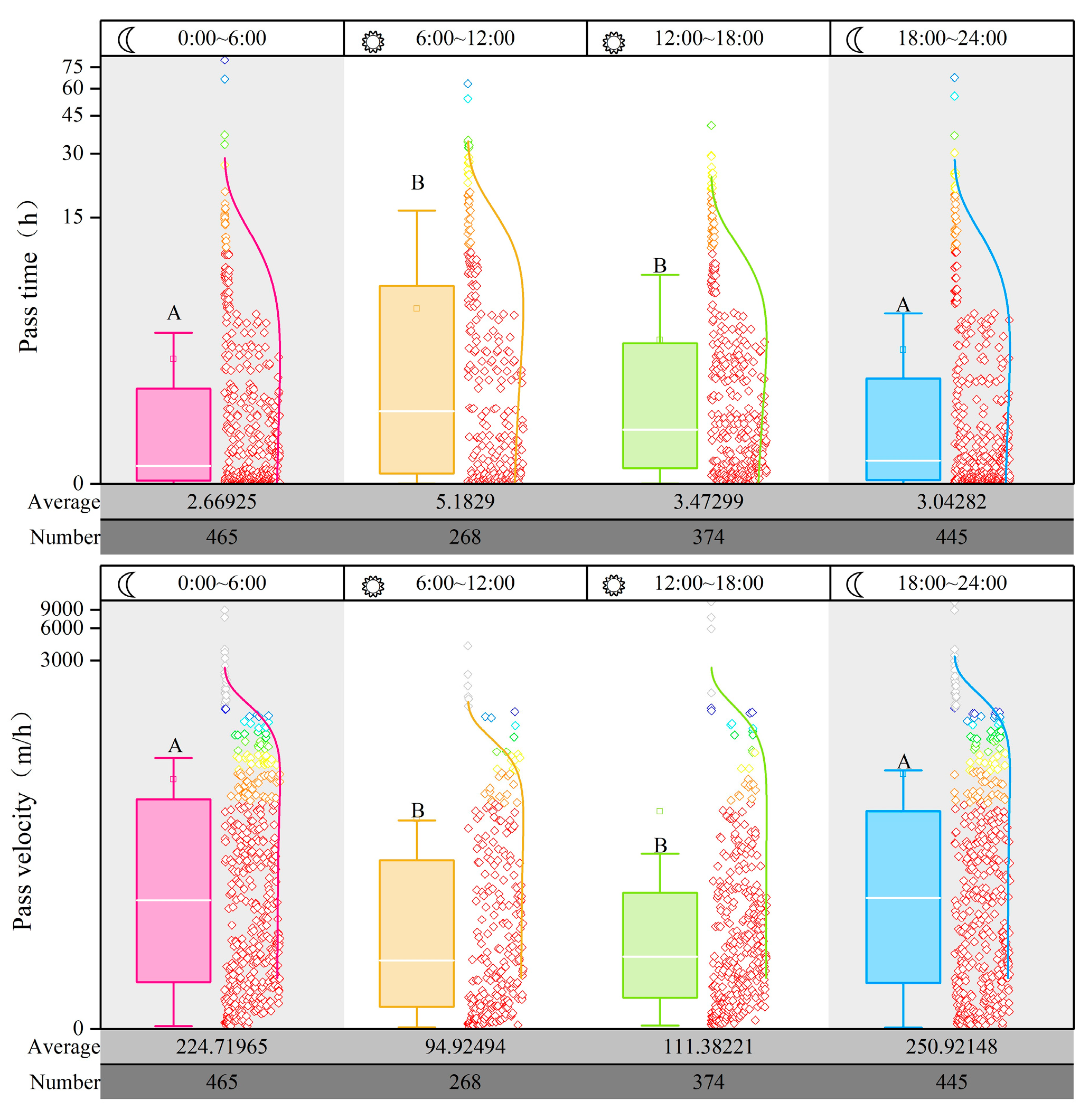

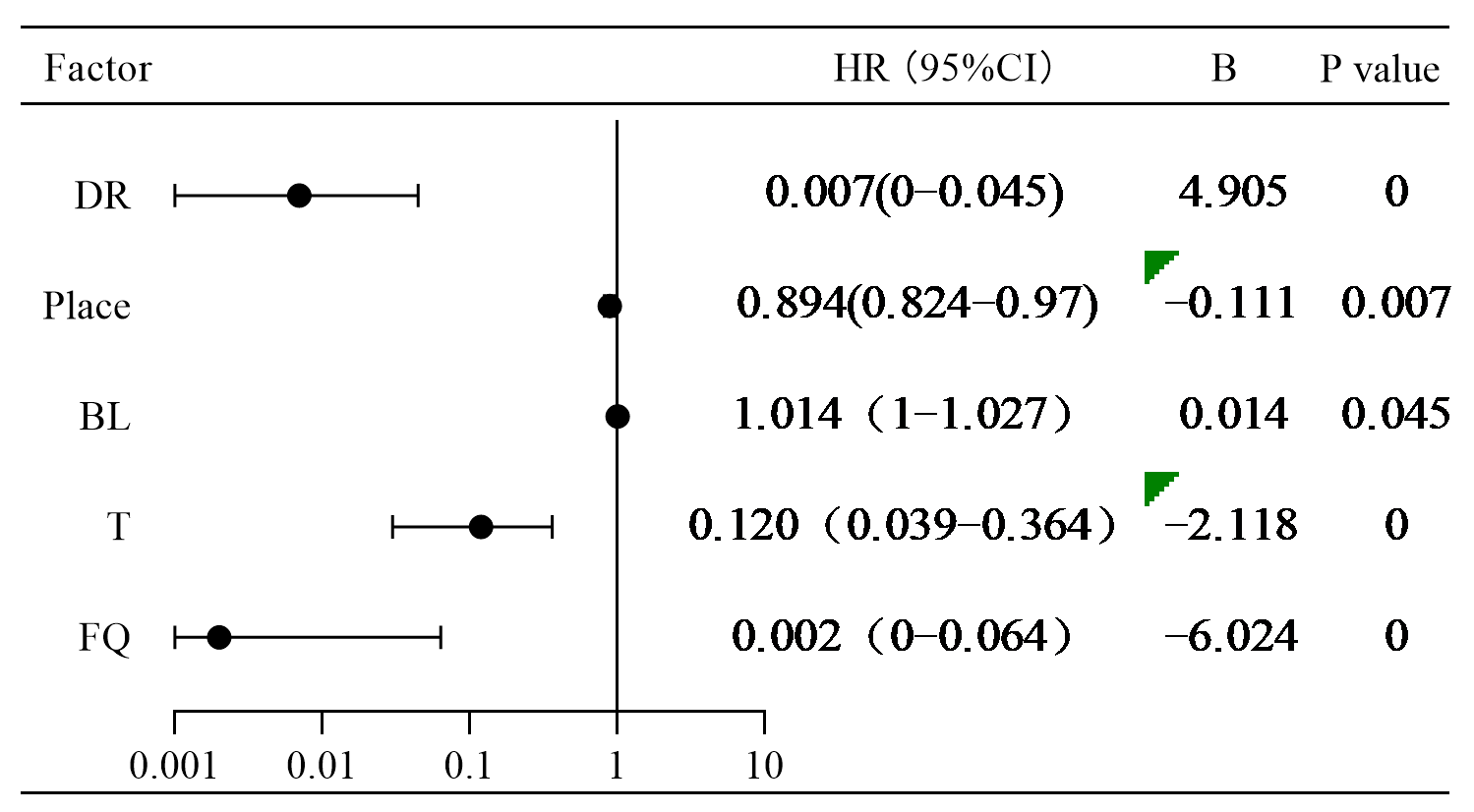

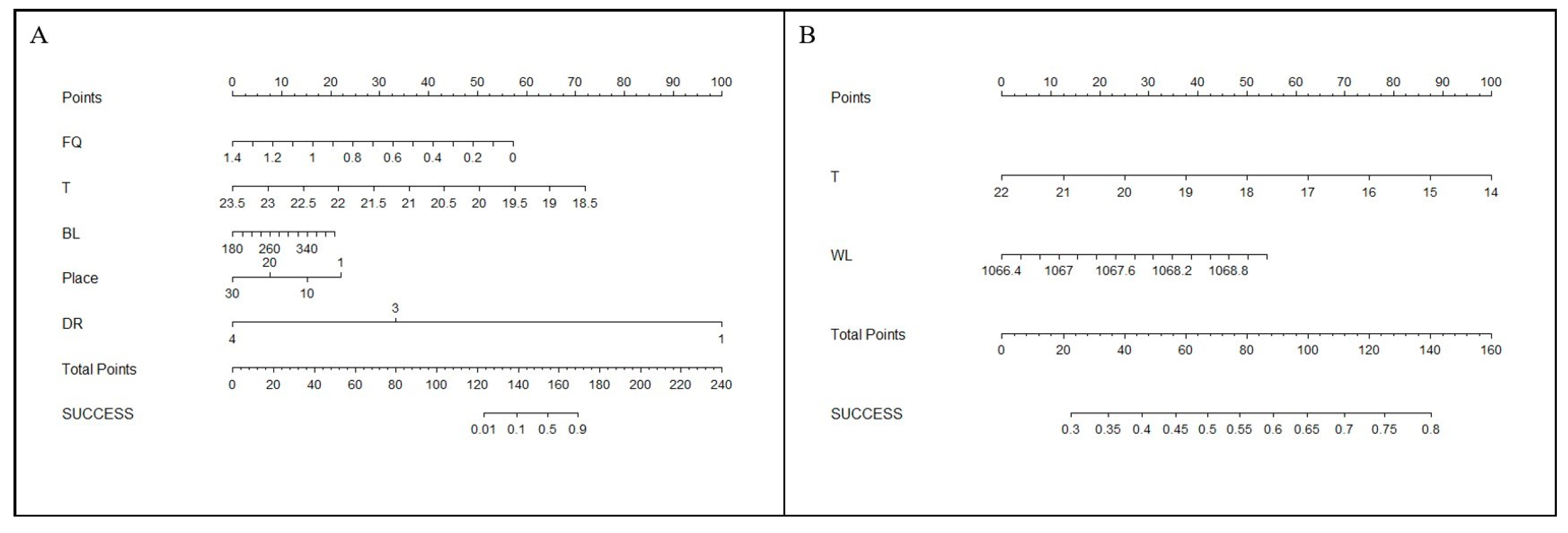
| Distance (m) | Attraction Rate (%) | Attraction Time (h) | Attraction Speed (m/h) |
|---|---|---|---|
| 1 | 40.00 | 40.1 ± 1.1 | 0.04 ± 0.05 |
| 10 | 6.67 | 80.29 ± 3.9 | 0.49 ± 0.29 |
| 20 | 14.00 | 194.3 ± 4.32 | 0.16 ± 0.15 |
| 30 | 2.13 | 269.2 | 0.11 |
| Number | Model | AIC | △IAIC | wi | wi/wj |
|---|---|---|---|---|---|
| 1 | FQ + BQ + T + BL + Place + DR | 123.21 | 1.97 | 0.271901 | 2.677812 |
| 2 | FQ + T + BL + Place + DR | 121.24 | 0 | 0.728099 |
| Number | Model | AIC | △IAIC | wi | wi/wj |
|---|---|---|---|---|---|
| 1 | FQ + T + BL + DR + WL | 584.11 | 1.98 | 0.13510908 | 2.691234472 |
| 2 | FQ + T + DR + WL | 582.13 | 1.22 | 0.197567926 | 1.840431399 |
| 3 | T + DR + WL | 580.91 | 0.36 | 0.30371278 | 1.197217363 |
| 4 | T + WL | 580.55 | 0 | 0.363610214 |
Disclaimer/Publisher’s Note: The statements, opinions and data contained in all publications are solely those of the individual author(s) and contributor(s) and not of MDPI and/or the editor(s). MDPI and/or the editor(s) disclaim responsibility for any injury to people or property resulting from any ideas, methods, instructions or products referred to in the content. |
© 2024 by the authors. Licensee MDPI, Basel, Switzerland. This article is an open access article distributed under the terms and conditions of the Creative Commons Attribution (CC BY) license (https://creativecommons.org/licenses/by/4.0/).
Share and Cite
Xu, J.; Li, D.; Hu, X.; Jiao, Y.; Wang, J.; Wu, Y.; Lin, C.; Ke, S.; Bai, T.; Wang, N.; et al. Quantitative Assessment and Regulation of Passage and Entrance Attraction Efficiency of Vertical-Slot Fishway on Heishuihe River in Southwest China. Animals 2024, 14, 2365. https://doi.org/10.3390/ani14162365
Xu J, Li D, Hu X, Jiao Y, Wang J, Wu Y, Lin C, Ke S, Bai T, Wang N, et al. Quantitative Assessment and Regulation of Passage and Entrance Attraction Efficiency of Vertical-Slot Fishway on Heishuihe River in Southwest China. Animals. 2024; 14(16):2365. https://doi.org/10.3390/ani14162365
Chicago/Turabian StyleXu, Jiawei, Dongqing Li, Xiaozhang Hu, Yilin Jiao, Jianping Wang, Yujiao Wu, Chenyu Lin, Senfan Ke, Tianxiang Bai, Nannan Wang, and et al. 2024. "Quantitative Assessment and Regulation of Passage and Entrance Attraction Efficiency of Vertical-Slot Fishway on Heishuihe River in Southwest China" Animals 14, no. 16: 2365. https://doi.org/10.3390/ani14162365






